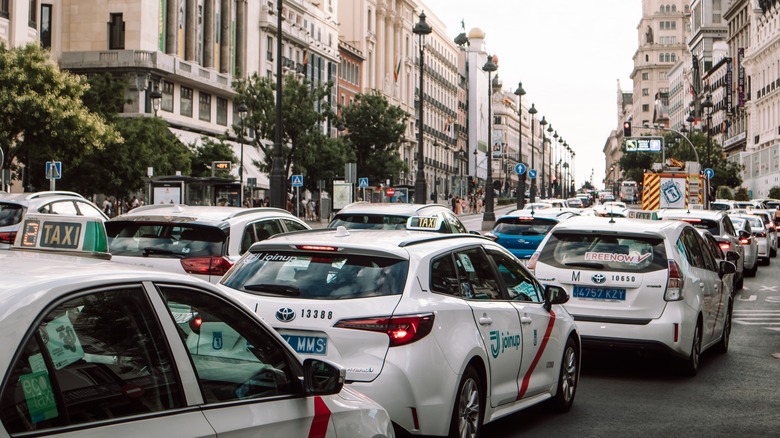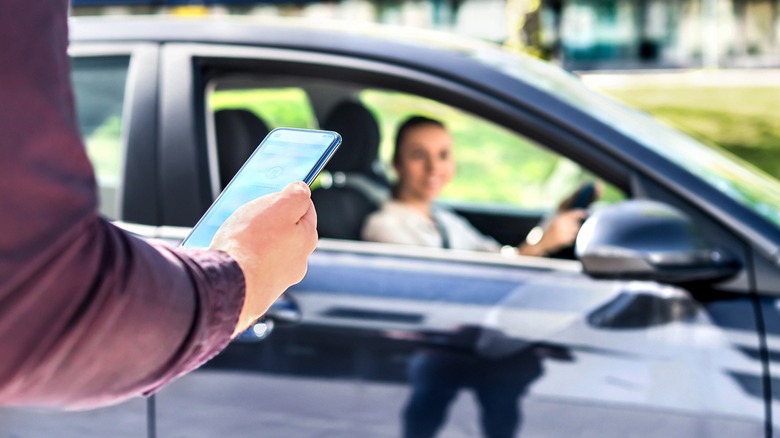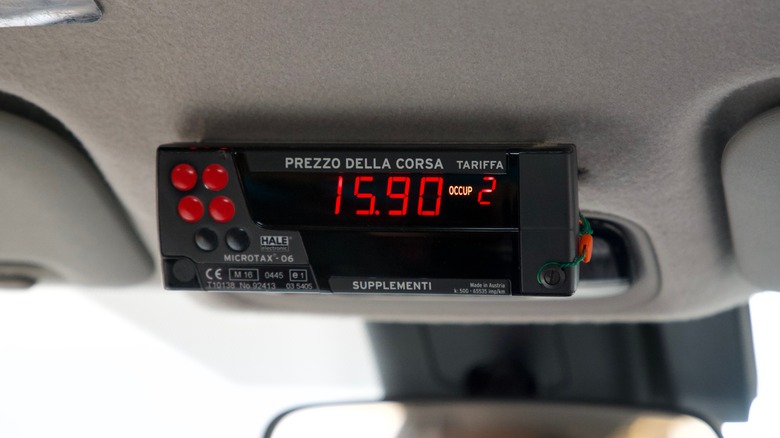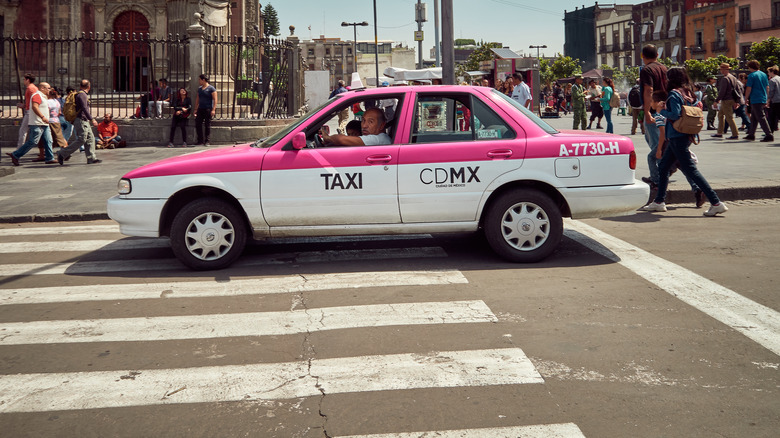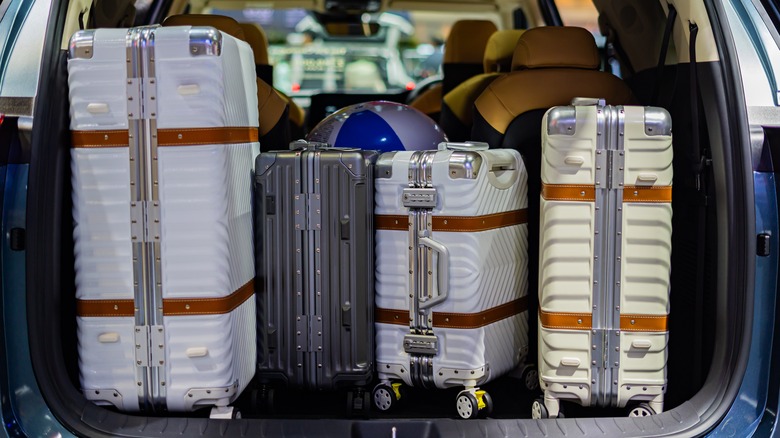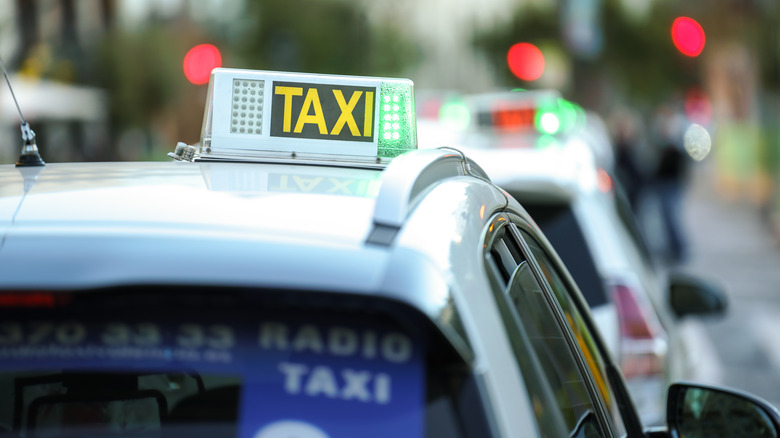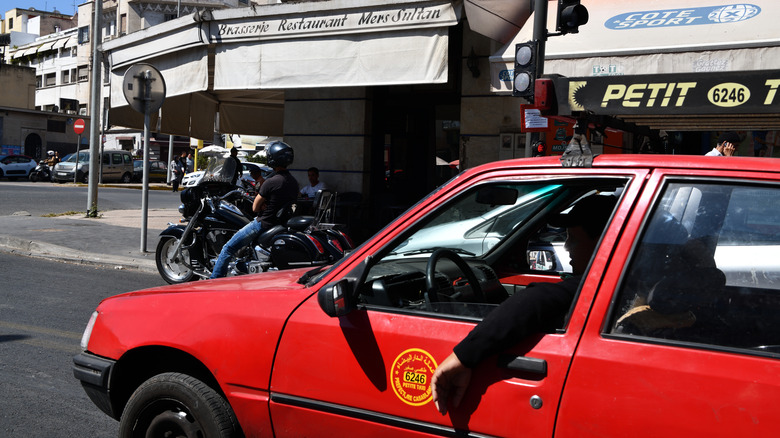12 Safety Tips You Need To Know Before Stepping Into Or Exiting A Taxi
Traveling is already pretty expensive just between your plane tickets, lodging, and meals. So, when it comes to taking taxis, travelers are usually mindful to avoid getting scammed out of hard-earned cash that they weren't planning on spending. Meanwhile, if you're traveling off the beaten path or to a high-risk destination, ensuring that you won't get robbed (or worse) is also a top priority. Fortunately, most problems with taxis can be avoided by taking a few simple precautions before stepping into the car. These include ensuring your driver is who he says he is, checking whether the cab is legit, and knowing when to open and close the door — yes, really.
Seems incredibly elementary? You're right. However, some tourists may expect the same level of trust and safety that they're used to in their home countries and could fail to observe these tips — leading to a loss of property and cash, or even dire situations that no one should have to deal with. Take the few seconds (literally) to follow these tips for a safer, fairer taxi ride.
Don't go with anyone randomly offering you a ride
When arriving in New York City's LaGuardia or John F. Kennedy International Airports, visitors will notice signs everywhere warning arrivals not to accept rides from drivers soliciting outside the terminal. This is not only because soliciting passengers always illegal, but these cabs are virtually guaranteed to be unlicensed, unregulated drivers looking to overcharge you (or worse). The typical modus operandi is to approach unwitting travelers in long taxi lines and offer the luxury of skipping the wait, especially at peak hours. They will approach you out of the blue and will be very insistent and convincing.
This may seem tempting, but it's best to wait in line. Unlicensed taxi drivers, once they've got you in the car, might quote you up to three or four times the metered or flat fare of a licensed ride. If the driver chooses to scam you, you have little recourse other than hoping the police catch them. You have no idea whether the driver is who they claim to be nor whether they have a criminal background. In certain places, this may mean exposing oneself to robbery, extortion, or even kidnapping in extreme cases. A properly licensed taxi, on the other hand, will prominently display the driver's license, name, and number, which should also ideally be printed on the side of the car. If you book by app, you can verify that the details on your phone match those in the car. If something goes wrong, you can file a complaint. That sketchy person who offered you the ride though? You won't even know whether their license plate is legit.
If the meter or card reader is broken, get out of the car
The taxi meter is a passenger's best friend. It shows you in big, red numbers exactly how much you owe, and there is no way the driver can get around that — unless, of course, it's "broken." Then the driver can charge you whatever they want as long as you, the tourist, are none-the-wiser. Some less scrupulous taxi drivers may either "forget" to start the meter or say it's broken, relying on the tourist's ignorance about local prices to overcharge you. Rome, for instance, is not just known for its "skip-the-line" scams, it's also known for "broken" taxi meters — although the problem is by no means unique to the Eternal City. Before getting in, make sure the meter works.
The proliferation of taxi and rideshare apps has made credit card and other cashless payments the norm, sometimes to the chagrin of taxi drivers. Apart from processing fees, some drivers love cash tips because they can conceal those earnings from tax authorities, which is something that cannot be done with digital payments. Thus, some drivers will try to force you to pay in cash by claiming their card readers are broken. Once again, don't fall for this one. Make it clear you will pay with a card before the ride starts, and if the driver has a problem, move on.
Don't get in without negotiating a price, if necessary
In the big tourist destinations of the United States and some parts of Europe, negotiating a taxi fare is a big no-go since cars are mostly metered. If you need to negotiate, it's probably because you're dealing with an unlicensed driver. In places where meter use is not ubiquitous and regulations are more lax, such as in Latin America and parts of Asia, you will face times when you have to negotiate your fare.
As a tourist, chances are that the initial fare offered will be massively inflated compared to what locals will get. It is not uncommon for drivers to scale prices depending on the traveler's country of origin (or sometimes other factors). If you did your due diligence as a tourist and researched what fares to expect, you can start haggling. Usually, offering 50% of the driver's initial offer is a good starting point.
It cannot be said enough: Never give in to pressure to just take the ride and settle on a fare later. If you get into the taxi without agreeing on a fare, you are potentially placing yourself in danger, since a dispute over money can escalate into arguments, threats, or worse. Agree on a price and stick to it. If the driver disagrees, move on to the next cab.
Tell a friend to wait for you at your destination
This one applies both at home and abroad for the purposes of establishing a paper trail, just in case emergency services need get involved. If you end up needing to file a police report, or if you forget something in the taxi and need evidence you were actually there, it's a good idea to let a friend know you are taking that ride in the first place. When you get in the taxi, text a friend — ideally someone also in the place you are visiting — the number of your ride, your destination, license plate, the driver's name, and the time you got into the cab. If you are using an app, you can use the app to share ride info, route, location, and your estimated time of arrival.
Once a trusted friend knows you are in the car, make sure the driver knows that this friend of yours is meeting you at your destination (even if it isn't true). This meant to protect you against crime and kidnapping on the part of the driver, especially in countries where taxis aren't the safest form of transportation. If the driver gets any ideas about harming you or delaying your arrival to your destination, they will have to think twice about whether to risk your friend reporting the fact that you are missing to the authorities. This is especially true if you texted the cab's information to your friend as well, because the police will know exactly whose car to look for if they open an investigation.
Don't put your belongings in the trunk
Putting your stuff in the trunk is a case-by-case situation — sometimes you can't avoid it, and most of the time, drivers aren't interested in stealing your stuff. But if you can keep your stuff with you, do it, because people tend to automatically close the taxi door behind them when exiting. In a relatively high-trust society like the United States, where taxi drivers are heavily regulated and, in the case of rideshares, tracked and monitored, this is less of a concern. However, it could still result in the driver driving off with your stuff, even by accident.
Abroad, the risks are higher, even in major tourist destinations like Rome. Johnny Jet, for instance, noted a story about a tourist losing her belongings after a Roman taxi driver drove off with her bags when she stepped out of the cab and closed the door. If all you lose are clothes, that's one thing. But if the taxi driver steals your passport and other travel documents, you're in trouble — especially if you are alone, without consular access, and do not speak the local language. If you use the trunk, play the door to your advantage.
Once you reach your destination, get out of the cab once the driver exits to unload your stuff. If the driver does not exit the cab, ask him to open the trunk and exit the cab curbside. Leave the door open until your stuff is unloaded. The driver cannot drive off without risking serious damage to his car, hitting pedestrians, or getting pulled over. In countries where taxi robbery is more frequent, cabs tend to have manual doors, leaving you in complete control of the situation and of your stuff.
Close the windows
This one may not seem obvious to Americans, given that robberies at stoplights are not quite as common as they used to be. But if you are traveling to dangerous locations in South America, the Philippines, or South Africa, robberies targeting stopped (not just parked) cars are still the norm. Sometimes, criminals will target cars with open windows and quickly snatch belongings from unsuspecting passengers at red lights and other busy intersections. One incident in the Philippines went viral after a thief snatched a lady's purse through the window of her taxi, while a similar front-seat robbery was also caught on camera in Manila.
Charles Rathbone, a veteran San Francisco taxi driver and curator of Taxi Library, recommends drivers and passengers keep themselves safe and comfortable by keeping the windows just slightly open, which is enough to speak to someone outside, like a police officer, but not so much that a hand can reach through and snatch any valuables from the seat or passenger. Obviously, this won't stop thieves from smashing windows, but they will likely look for easier targets rather than go through the work of breaking glass on a car that might accelerate at any second.
Touch the window or leave hair in the taxi
While no tourist wants to ever go through the ordeal of being a victim of a taxi kidnapping or some other crime, the reality is that from time to time, sadly, it happens. If you are taking a taxi, especially in a country with a functioning justice system, NYC's iHeartRadio recommends touching the window and leaving some of your hair in the cab. This step could be the difference between the perpetrators getting caught and getting off.
The rationale behind this one is to ensure that if something horrible does happen, there is evidence to link you to the taxi, preventing the driver and any accomplices from claiming that you were never there. For instance, if you are driven off in a taxi to a remote location and robbed, you will need to tie the driver to the crime. If you already did your due diligence upon entering, you got the taxi number, license, and driver's name — which you should always be getting this information regardless. The next step is proving you were in the car, which is most easily done through biometric and DNA evidence. If you leave fingerprints on the window or hair in the car, investigators will likely have good evidence you were there, making prosecution of the offenders considerably easier and helping you get justice.
Don't sit in the front seat and stay on the right-hand passenger seat
Sitting in the front seat may seem convenient if you are traveling in a group or have to share the taxi with others, and the back is full. From a safety perspective, however, sitting up front is a gamble. If the driver wants to assault you, harass you, or in any way intimidate you, they will have a much easier time of it if they are right next to you. Instead of sitting in the front seat, head for the right-hand-side passenger seat, which gives you a clear view of the driver and a quick exit through the passenger door. Furthermore, in most places, the right-hand seat is the curbside seat, so you won't be exiting into oncoming traffic.
Fortunately, most drivers won't want you in the front seat. Taxi drivers are often crime victims, too, and a well-intentioned driver is at the mercy of a front-seat passenger with bad intentions. Thus, it is in everyone's interest for the passenger to stay in the back and leave the front empty. Be aware, however, that in some places, like Australia, the Netherlands, and Scotland, taxi etiquette may surprise you, and you may be encouraged to sit up front when solo. If you are in a country where this is the norm, go with your gut and wait for the next taxi if the driver seems a bit too insistent. Otherwise, it's generally fine to respect local customs.
Pay with exact change if possible — or close to it
Before getting out of the taxi, you have to pay your fare. If you want to make the driver's day, pay in cash, and make sure you do it right. Try to get as close to the exact amount as possible with small bills. The reasoning behind this is that dodgy cab drivers have some not-so-creative and, frankly, pretty obvious ways of separating you from your money. The only reason these scams work is because many tourists don't bother to check until it's too late.
Fortunately, Rick Steves' guide to avoiding European taxi scams is a lifesaver here. As Rick Steves explains on his website, say you pay with a 50 euro bill. A crooked driver may "accidentally" drop the 50 and show you a smaller bill, like a 20, pretending that was what you gave them originally and claim you still owe 30. Of course, the driver is banking on either you staying mum or intimidating you if you call them out.
The other scam involves simply not giving you correct change, such as giving you five euros in change instead of 15 or 20 and hoping you won't bother to count your cash until it's too late. Both of these scams can be avoided by using small bills and getting as close to the exact amount as possible. The driver cannot give you the wrong change if there is no change to give. Make sure to count the money out loud in front of them as you give it. That way, they can't claim you are trying to underpay.
Don't give away any personal details
It's normal to want to talk to your taxi drivers — in fact, some welcome it. They are often eager to learn about other parts of the world and your experiences while potentially practicing their English. When chatting, however, be aware of how much you share about your personal life.
Don't air any personal drama to the taxi driver. While discussing it won't usually result in harm, it might be culturally inappropriate and lead to unwelcome advances if you give the hint that you are single. Never tell the driver exactly where you are staying — the exception being the hotel you're traveling to. In that case, never give them your room number. Don't share your occupation, finances, or social status if you can avoid it. In countries where kidnapping for ransom and robbery are a problem, these topics are great ways to tell a rogue taxi driver that you're a lucrative target.
So, what can you talk about? Strangely enough, although talking politics, religion, and culture is one of those things that may drive locals up the wall, it's not a bad topic for the taxi, as long as you are respectful and willing to learn without butting in with preconceived notions. Otherwise, if you want to play it safe, stick to sports, movies, or similar trivia. In many countries, these are popular topics, and drivers may love to regale you with stories about their favorite teams or films — and hear about yours.
Pay careful attention to your route
This one is for those using taxi apps. Today, you have the convenience of getting the best route with the app GPS. An honest driver will follow that route to the letter unless a sudden change like an accident or road closure prevents them from doing so because that's how the fare is calculated at the start of the ride. In that case, they should immediately offer an explanation for changing the route unprompted. If the driver deviates from the route without reason, say something. You have the right to know why they are doing this and get reassurances that you are not being driven to some sketchy part of town to be robbed or extorted. If the driver gives you an explanation and it doesn't sound convincing, that's a sign to get out of the car if it is safe to do so. Fortunately, using the app, you can check whether their explanation checks out.
If you do not have a GPS and getting scammed is a concern, then do your research before even getting the taxi. Ask a local for the best way to get to your destination, use a navigation app such as google maps, and then use that info to explain to the driver exactly how you want to get there. If the driver seems honest and offers you an alternate route that you can verify is faster (or at least won't take you through sketchy parts of town or break the bank), then go with your gut.
